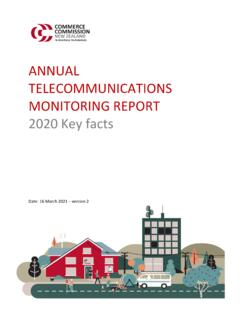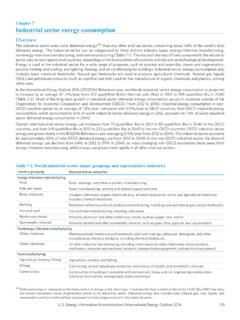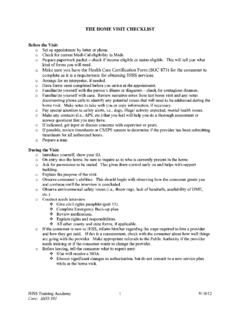Transcription of Market study into the retail grocery sector - Commerce …
1 Market study into the retail grocery sectorDraft report Executive summary $ KGMarket study into the retail grocery sector1 ContentsOverview 2 Key findings 3 Price, profits and innovation 4 Market duopoly and high barriers to entry 4 Issues facing consumers 5 Issues facing suppliers 5 Options for recommendations 6 Other matters of interest to the Commission 6 Summary of our analysis 7 Profitability 7 Major grocery retailers are earning excess levels of ROACE 7 Business cases show high expected rates of return 8 Profit margins have been consistent over time and above international comparators 8 International price comparisons 8 Innovation and investment 9 Online retailing 9In-store innovations 9 Innovations targeted at efficiency 9 Consumer preferences when shopping for groceries 9 Many consumers prefer to buy their groceries at a one-stop shop 10 Consumers typically travel short distances to buy groceries 10 There are regional
2 Differences in grocery retail options available 10 Competition at the retail level 11 Competition with the fringe of competing retailers 11 Meal kit providers provide an additional convenience option for consumers 11To what extent does the fringe of other grocery retailers compete with the major grocery retailers? 12 How intense is the level of competition between the major grocery retailers? 12 Conditions of entry and expansion 13 Lack of wholesale grocery supply on competitive terms 13 Constraints on site availability 14 Issues facing consumers 14 The use of multiple promotional mechanisms and how they are framed distorts consumer decision making and lessens competition 14 Loyalty programme membership is popular 15 Consumer understanding of loyalty programmes is low and this can affect competition 15 Loyalty programmes can also affect some consumers willingness to shop around 16 Issues facing suppliers 16 Transferring costs and risks from retailers to suppliers 17 Reduced transparency and certainty over terms of supply 17 Limiting suppliers ability or incentive to provide favourable supply terms with other retailers 17 Private label products 17 Options for
3 Recommendations 18 Increasing wholesale access to a wide range of groceries at competitive prices 18 Free up sites for retail supermarkets 19 Directly stimulate retail competition 19 Supplier Code of Conduct 20 Pricing and promotional practices 20 Increased transparency for loyalty programme terms and conditions 20 Have your say 21 Market study into the retail grocery sector2 OverviewThis report sets out our preliminary findings from our study into New Zealand s retail grocery sector . The purpose of the study is to examine whether competition in the grocery sector is working well and, if not, what can be done to improve it. Groceries are an essential purchase for all consumers as well as a major expense for most households. In the year to December 2020, more than $22 billion was spent at supermarkets and grocery stores.
4 In the year to June 2019, food was the second largest expense for New Zealand households, with an average spend of $234 a high level of concentration in the sector , potential competition concerns and the prices consumers pay for their groceries were reasons cited by the Minister of Commerce and Consumer Affairs for asking us to undertake this study . Our study is focused on understanding competition in the grocery sector and does not look at other factors which may be affecting grocery prices such as tax, freight and labour costs, inflation, or seasonality. If competition is working well for consumers in the long term, we would expect to see grocery retailers competing to deliver consumers the range and quality of products at the right price to satisfy their preferences. In a competitive Market , businesses are also incentivised to innovate and there is ongoing pressure on firms to attract and retain consumers.
5 These dynamics mean that firms profits are limited over study focuses on the retail supply of groceries to New Zealand consumers. This includes meat, fruit and vegetables, canned goods, dairy products, and a range of other household products, like toilet paper, cleaning products and pet food . Our study also includes alcohol and tobacco where these are sold by grocery retailers. We have not analysed the grocery sector s immediate response to COVID-19 or its short-term effects on competition. However, we have considered whether any issues or practices that have emerged during the pandemic are likely to affect competition in the longer term. The retail grocery sector is diverse and made up of a range of retailers catering to the needs of a similarly diverse range of consumers through a mix of supermarkets, specialist and international food stores, convenience stores, online-only supermarkets and meal kit providers.
6 Market study into the retail grocery sector3 Prominent in the sector are two major operators of nationwide supermarket chains: Woolworths New Zealand Limited (Woolworths NZ) and Foodstuffs. These supermarket chains are a significant focus for our study . Throughout this report, we refer to them as major grocery retailers and to those grocery retailers that are not part of these groups as other grocery retailers .Consumers engage in a range of different shopping missions, including: a main shop typically at weekly, or at another regular interval, based on the convenience of using one grocery store to get all necessities in one place a secondary shop for specific products, typically at a specialist retailer, and/or a top-up shop for a small number of items, often across a range of other grocery retailers.
7 While New Zealanders have a diverse range of preferences for why, where and how they shop, a significant proportion of consumers prefer to buy groceries during a main shop in one location at one of the major grocery retailers supermarkets. Therefore, other grocery retailers are more likely to be regarded by consumers as an alternative for top-up or smaller shopping NZ operates and supplies more than 180 Countdown stores throughout New Zealand. Woolworths NZ also owns Wholesale Distributors Limited, which is the franchisor to 71 locally-owned and operated SuperValue and Fresh Choice stores, which mainly operate in smaller operates as two separate cooperatives: Foodstuffs North Island (Foodstuffs NI) and Foodstuffs South Island (Foodstuffs SI). There are more than 400 Foodstuffs retail stores nationwide operating under the New World, PAK nSAVE and Four Square banners, as well as Raeward Fresh and On the Spot stores in the South Island.
8 The major grocery retailers are also wholesalers, but largely only supply themselves. They own and operate central distribution centres which supply their retail stores throughout the country. There are some other independent wholesalers which supply retailers with some product categories like fresh produce, meat, and international products. The breadth of wholesale supply options available to the other grocery retailers affects the extent to which they can compete with the major grocery retailers for a consumer s main shop. The wholesale purchasing of groceries by retailers from growers and other food and grocery producers has also been a significant focus for our study . The major grocery retailers supermarkets are a critical route to Market for many suppliers. Further, consumers benefit from better products when suppliers have the ability and incentive to invest and findingsOur preliminary finding is that competition is not working well for consumers in the retail grocery sector .
9 If competition was more effective, retailers would face stronger pressures to deliver the right prices, quality and range to satisfy a diverse range of consumer preferences. In reaching our preliminary finding we have identified a range of Market outcomes that we consider are inconsistent with what we would expect to see in a workably competitive Market including prices, innovation and profitability. We have then analysed aspects of competition that we consider may be contributing to these outcomes. They are the structure of the grocery retailing industry, the conditions for entry and expansion by potential rivals, consumer preferences and the way retailers compete for and interact with consumers, and issues associated with retailers wholesale purchasing of groceries from suppliers. Market study into the retail grocery sector4 Price, profits and innovationWe have observed consistently high profits being earned by the major grocery retailers.
10 If competition was working better, we would expect these profits to attract new entry and expansion by other grocery retailers, bringing profitability back to a more competitive, or normal , it is difficult to compare grocery prices internationally, it appears that New Zealand prices are relatively high by international also appears that while there has been innovation in the sector , it is modest by international standards. High profits do not appear to be rewarding retailers who have invested in innovation, as slow adopters also appear to enjoy duopoly and high barriers to entry The retail grocery sector can best be described as a duopoly with a fringe of other competitors. While there are a number of different retail banners in New Zealand, the grocery Market is dominated by Foodstuffs and Woolworths NZ s supermarket chains.








